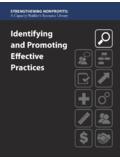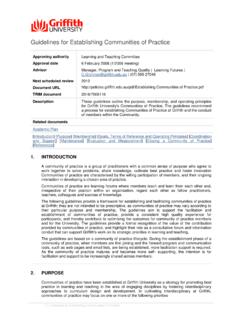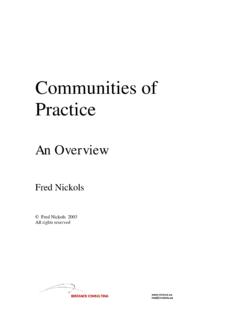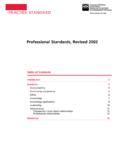Transcription of Reducing in-school variation
1 Reducing in-school variation Making effective practice standard practice Contents 1. Planning and working to reduce in-school Taking action on in-school Leading the way on in-school in-school variation and the wider school improvement Further I: conveying the II: using data to identify and measure in-school III: tools for implementing an in-school variation 2 of 40 1. Introduction Schools have made many successful improvements in recent years, resulting in increased effectiveness and higher levels of achievement. This guide provides an approach. That encourages schools to learn from within , to ask questions about how and why practice differs within the school and explore ways of identifying and spreading the best possible practice. A key aim of learning from within is to reduce the level of internal, or in-school , variation (ISV) across areas of organisation, teaching and learning that have a direct impact on student achievement.
2 Reducing ISV is not an end in itself and shouldn t result in inflexible uniform practice regardless of a school s culture, traditions and existing improvement plans. Rather, it is intended to ensure that practices the school has identified as effective for improving learning and raising student achievement are adopted as widely as possible across all subjects. In short, to help ensure that effective practice becomes everyday practice for all. Some schools have made considerable advances in this area, comparing and analysing differing levels of achievement across subjects and establishing links between baseline measures, such as key stage 2 and cognitive ability test (CAT) scores, and public examination results. Findings have been used to demonstrate good practice and raise expectations of both teachers and students. In many cases, this work has resulted in a change in the school s culture and the benefits of sharing good ideas and effective ways of teaching are clear.
3 In others, a change of attitude towards working collaboratively may be required before effective learning from within can begin. Learning from the exploration of ISV helps schools integrate improvement initiatives. For example, positive developments made in one subject area, that might otherwise remain discrete, can be disseminated and benefit the whole school . If staff are aware of ISV, it encourages them to share their most effective approaches to teaching and learning and consider using practices that have worked well elsewhere in school . This means the exploration of ISV and learning from within can potentially foster an environment where analysis, innovation and sharing result in higher levels of professional satisfaction and student achievement. ISV in the context of the wider school improvement picture is discussed in section six. This guide has been jointly produced by the Training and Development Agency for Schools (TDA) and the National College for school Leadership (NCSL)a as part of the national drive to raise levels of achievement.
4 The guide is intended for head teachers and senior leadership team in the first instance, but we recommend that all staff have access to it. This will ensure the nature of ISV is widely understood and provide a sound basis for school -wide collaboration. Staff with middle leadership responsibilities will find that the guide has particular relevance to them. Overall the guide provides: a The key purpose of the TDA is to raise children s standards of achievement and promote their well-being by improving the training and development of the whole school workforce. The NCSL works to make a difference to children s lives through excellent school leadership, supporting current and future school leaders so that they can have a positive impact within and beyond their schools. Page 3 of 40 Direction for thinking and planning on ISV Practical advice on identifying , analysing and Reducing ISV A framework for sharing and embedding effective practice across the school A foundation for the continuing professional development (CPD) of individual teachers Sections three to five form the core of the guide and offer advice and practical techniques on addressing and tackling ISV.
5 The tables in appendix III are working tools designed to facilitate investigation into ISV and support the planning, initiation, implementation and evaluation of an ISV programme. In time, action to reduce ISV should be an everyday process for any school . The How it works examples presented throughout the guide are intended to give an insight into how some schools have already approached ISV reduction and achieved positive outcomes. They demonstrate the value of having manageable stages and clear cut goals within a well-defined overall strategy for tackling ISV. The guide is principally aimed at secondary schools and has a subject/department-based orientation. A companion guide for primary schools is scheduled to follow. Page 4 of 40 2. Background The UK education system has one of the highest levels of variation in student outcomes within the Organisation for Economic Cooperation and Development (OECD). Results from the Programme for International Student Assessment (published in 2002) showed that as much as 80 per cent of the variation in achievement among UK students lay within schools four times more than that which occurred between different schools.
6 The high level of variation within UK schools has a number of causes. In secondary schools one of the causes of in-school variation (ISV) is differences in practices across subject departments. Recent research and development projects have demonstrated that tackling this between department component of ISV offers an important driver for improvement1. In 2003, the Department for Children, Schools and Families (DCSF) (then the Department for Education and Skills) worked in partnership with the NCSL to support a project exploring how the reduction of within school variation might form an important element of a school s improvement strategy. The project was largely practitioner-led in the form of research by schools for schools. Schools participated in two phases from 2003 to 2007 with encouraging There was sound evidence of a reduction in variation between subjects, and of a value-added improvement in students results at key stages 3 and 4.
7 Crucially, the secondary schools that reduced the extent of variation lifted their overall results. Extensive evaluation of both phases of the project was undertaken3 with the aim of establishing the most effective means of Reducing ISV and increasing overall performance. The work carried out with schools between 2003 and 2007 provided the foundation for further school -based developmental work by the TDA and the NCSL working with 20 secondary schools in 2009. This work was supported by PricewaterhouseCoopers and the University of Manchester who also evaluated the trial and an initial version of this guide. This version of the guide has been produced largely in the light of the findings from that trial. Page 5 of 40 3. Planning and working to reduce in-school variation Taking a fresh approach to school improvement, in the context of ISV, requires a good strategy to ensure anticipated outcomes are realised. To date, schemes that have focused on a limited number of goals have been most successful in their initial impact and the literature suggests stand a better chance of being sustainable in the longer term.
8 Similarly, programmes with clear and reportable progress indicators are more likely to sustain their momentum. The head teacher and senior leadership team will need to play a central role in the leadership of ISV work (see section five). All schools have the potential to address ISV at some level, taking into account individual circumstances, school culture, and experience of trying new approaches. It s important for schools to ensure they have sufficient capacity to introduce and maintain a successful ISV reduction strategy. A strategy which attempts to address the issue on all fronts simultaneously will be difficult to manage and sustain. Initially, most staff members will need to gain a common understanding of the nature of ISV, where it most commonly occurs and how it is identified. Appendix I provides some guidance on securing a common understanding of the concept of ISV and signposts areas where action may be needed. The diagram in appendix I provides a general framework for identifying and tackling ISV and parts of it could be expanded to create a working strategy document.
9 Early work, reinforced by the TDA/NCSL trial, indicated that there are five key areas where steps taken to reduce variation are likely to be most effective. They are: The collection and use of data The role and effectiveness of middle leadership The quality of teaching and learning Listening and responding to student voice Standardising procedures Section of this guide explores how variation in these areas can be addressed. The trial schools that successfully addressed ISV began by investing significant time in building a clear picture of its nature and scale, and formulating specific strategies to reduce it. Page 6 of 40 How it works: making a successful start to Reducing ISV A school that successfully develops an ISV reduction strategy invests significant time in identifying and understanding its ISV pattern and deciding priorities for action. This allows the school to build a clear vision of its goals before going on to identify specific activities that will help achieve those goals.
10 Attention may focus on a small range of strategies so that action can be taken sooner rather than later. Staff engagement is secured early on, probably through a project launch, and most of the activity involves staff working collaboratively to identify and implement strategies that strengthen teaching and learning. These can include observing each other in the classroom, and sharing skills and experience through collaborative CPD. The focus should not be so narrow that individual staff feel threatened or singled out. Students are recognised as learning partners and their contribution to improving teaching and learning is valued and actively sought. To achieve quick wins, the school considers how to standardise procedures that are associated with ISV; changes here can have an immediate and powerful effect. Planning at the start Conduct a data audit (see appendix II) to identify and prioritise a strategy for Reducing ISV Decide on a limited number of focused ISV-related goals and stick to them Be consistent with the school s priorities, presenting ISV work as an opportunity to move things forward in new ways Be clear on the school s capacity to manage ISV work and scale it accordingly Build in sufficient planning and monitoring time for key members of staff Ensure all staff realise that Reducing ISV is a new approach and that they properly understand what is involved Page 7 of 40 How it works: spreading effective teaching practice a clear goal A large, specialist secondary school in an inner city location has recently achieved excellent student attainment results in its specialism.

















